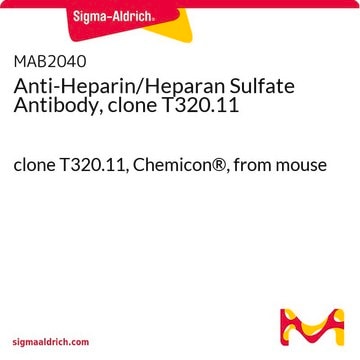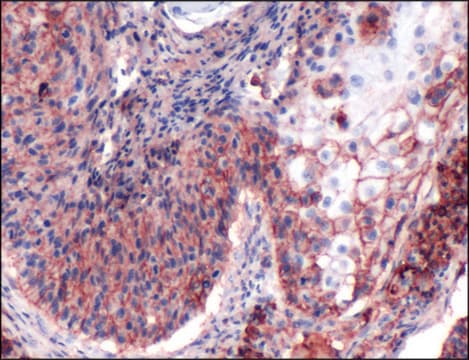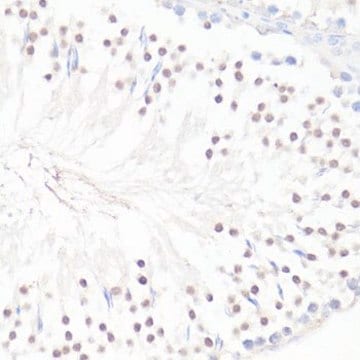MABF3163
Anti-CD44 Antibody, clone HERMES-3
Synonyme(s) :
CD44 antigen, CDw44, ECMR-III, Epican, Extracellular matrix receptor III, GP90 lymphocyte homing/adhesion receptor, HUTCH-I, Heparan sulfate proteoglycan, Hermes antigen, Hyaluronate receptor, PGP-1, Phagocytic glycoprotein 1
About This Item
Produits recommandés
Source biologique
mouse
Niveau de qualité
Forme d'anticorps
purified antibody
Type de produit anticorps
primary antibodies
Clone
HERMES-3, monoclonal
Poids mol.
observed mol wt ~85-95 kDa
Produit purifié par
using protein G
Espèces réactives
mouse, human
Conditionnement
antibody small pack of 100
Technique(s)
ELISA: suitable
flow cytometry: suitable
immunocytochemistry: suitable
immunofluorescence: suitable
immunohistochemistry: suitable
immunoprecipitation (IP): suitable
inhibition assay: suitable
western blot: suitable
Isotype
IgG2aκ
Séquence de l'épitope
Extracellular domain
Numéro d'accès Protein ID
Numéro d'accès UniProt
Température de stockage
-10 to -25°C
Informations sur le gène
human ... CD44(960)
Spécificité
Immunogène
Application
Evaluated by Western Blotting in Human fetal foreskin tissue lysate.
Western Blotting Analysis: A 1:500 dilution of this antibody detected CD44 in Human fetal foreskin tissue lysate.
Tested Applications
Western Blotting Analysis: A 1:500 dilution from a representative lot detected CD44 in human tonsil tissue extracts.
ELISA Analysis: A representative lot detected CD44 in ELISA applications (Torrado, E., et al. (2013). PLoS One. 8(4):e61681).
Immunocytochemistry Analysis: A representative lot detected CD44 in Immunocytometry applications (Picker, L.J., et al. (1989). J Cell Biol. 109(2):927-37).
Flow Cytometry Analysis: A representative lot detected CD44 in Flow Cytometry applications (Jalkanen, S., et al. (1987). J Cell Biol. 105(2):983-90; Zhang, N., et al. (2012). Nat Immunol. 13(7):667-73).
Inhibition Assay: A representative lot selectively inhibited lymphocyte binding to lymph node and mucosal high endothelial venules. (Jalkanen, S., et al. (1987). J Cell Biol. 105(2):983-90).
Immunohistochemistry Applications: A representative lot detected CD44 in Immunohistochemistry applications (Huang, Z., et al. (2014). J Immunol.;192(11):5285-95).
Western Blotting Analysis: A representative lot detected CD44 in Western Blotting applications (Picker, L.J., et al. (1989). J Immunol. 142(6):2046-51; Picker, L.J., et al. (1989). J Cell Biol. 109(2):927-37).
Immunofluorescence Analysis: A representative lot detected CD44 in Immunofluorescence applications (Huang, Z., et al. (2014). J Immunol.; 92(11):5285-95).
Immunoprecipitation Analysis: A representative lot detected CD44 in Immunoprecipitation applications (Jalkanen, S., et al. (1987). J Cell Biol. 105(2):983-90).
Note: Actual optimal working dilutions must be determined by end user as specimens, and experimental conditions may vary with the end user.
Description de la cible
Forme physique
Reconstitution
Stockage et stabilité
Autres remarques
Clause de non-responsabilité
Not finding the right product?
Try our Outil de sélection de produits.
Code de la classe de stockage
12 - Non Combustible Liquids
Classe de danger pour l'eau (WGK)
WGK 2
Point d'éclair (°F)
Not applicable
Point d'éclair (°C)
Not applicable
Certificats d'analyse (COA)
Recherchez un Certificats d'analyse (COA) en saisissant le numéro de lot du produit. Les numéros de lot figurent sur l'étiquette du produit après les mots "Lot" ou "Batch".
Déjà en possession de ce produit ?
Retrouvez la documentation relative aux produits que vous avez récemment achetés dans la Bibliothèque de documents.
Notre équipe de scientifiques dispose d'une expérience dans tous les secteurs de la recherche, notamment en sciences de la vie, science des matériaux, synthèse chimique, chromatographie, analyse et dans de nombreux autres domaines..
Contacter notre Service technique








